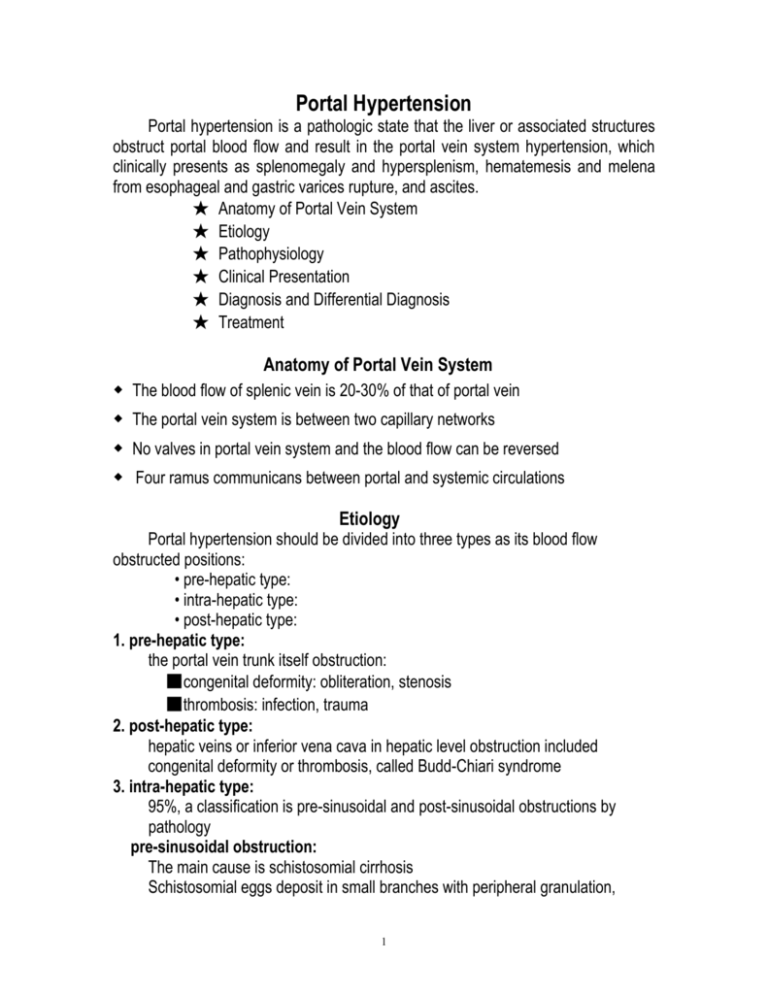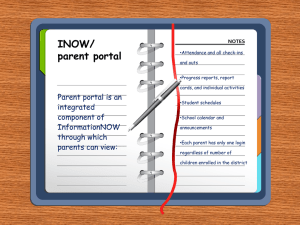Portal Hypertension
advertisement

Portal Hypertension Portal hypertension is a pathologic state that the liver or associated structures obstruct portal blood flow and result in the portal vein system hypertension, which clinically presents as splenomegaly and hypersplenism, hematemesis and melena from esophageal and gastric varices rupture, and ascites. ★ Anatomy of Portal Vein System ★ Etiology ★ Pathophysiology ★ Clinical Presentation ★ Diagnosis and Differential Diagnosis ★ Treatment Anatomy of Portal Vein System ◆ The blood flow of splenic vein is 20-30% of that of portal vein ◆ The portal vein system is between two capillary networks ◆ No valves in portal vein system and the blood flow can be reversed ◆ Four ramus communicans between portal and systemic circulations Etiology Portal hypertension should be divided into three types as its blood flow obstructed positions: • pre-hepatic type: • intra-hepatic type: • post-hepatic type: 1. pre-hepatic type: the portal vein trunk itself obstruction: ■congenital deformity: obliteration, stenosis ■thrombosis: infection, trauma 2. post-hepatic type: hepatic veins or inferior vena cava in hepatic level obstruction included congenital deformity or thrombosis, called Budd-Chiari syndrome 3. intra-hepatic type: 95%, a classification is pre-sinusoidal and post-sinusoidal obstructions by pathology pre-sinusoidal obstruction: The main cause is schistosomial cirrhosis Schistosomial eggs deposit in small branches with peripheral granulation, 1 resulting in obstruction of blood flow and increase of portal pressure post-sinusoidal obstruction: The main cause is post-hepatitis cirrhosis (1) Fibroplasia and regeneration of hepatic cells compress the hepatic sinus, reducing in obstructed blood flow and increased portal vein pressure (2) The shunts between terminal hepatic arteries and portal veins open, and thehepatic arteries blood flow with high-pressure perfuse directly into low-pressured portal veins, which contributes to portal hypertension (3) The high hepatic resistance can affect the hepatic lymphatic back-flow, which will further increase the portal pressure Pathophysiology The normal pressure of portal vein: 13 to 24cmH2O Portal hypertension: 30 to 50cmH2O ★ congestive splenomegaly ★ ramus communicans dilatation ★ ascites 1. congestive splenomegaly and hypersplenism: 2. ramus communicans dilatation: esophageal and gastric veins: varices rupture and gastrointestinal hemorrhage inferior rectal-anal veins: hemorrhoid and bleeding anterior abdominal wall veins: paraumbilical varices (caput medusae) numerous retroperitoneal veins: dilatation and congestion 3. ascites : disordered albumin synthesis and decreased plasma colloid osmotic pressure caused by hepatocellular function damage increased capillary filter pressure due to increased portal hypertension lymph liquid leakage into abdominal cavity from surface of the liver because of lymph back-flow obstruction salt and water retention by aldosterone and antidiuretic hormones deactivation disturbance ★ portal hypertensive gastropathy ★ hepatic or portosystemic encephylopathy Clinical presentation ☛ splenomegaly and hypersplenism: ☛ hematemesis and melena ☛ ascites 2 Diagnosis and Differential Diagnosis Diagnosis ▣medical history: hepatitis or schistosomiasis ▣clinical presentation: splenomegaly and hypersplenism hematemesis and melena ascites ▣ investigations: ◧ blood routine examinations: leukocytopenia and thrombocytopenia ◨ liver function tests: albumin↓, A/G ratio reversing, prothrombin time↑ ◩ serological markers of hepatitis B or C: ◪ esophageal barium swallow: multiple irregular filling defects as “string of beads” or “earthworm” ◧ esophageal endoscopy: white, pink, red, cherry red varices ◨ ultrasound and Doppler: cirrhosis, splenomegaly, ascites, thrombosis and occlusion of the portal, superior mesenteric and splenic vein, enlargement of portal vein>13mm and of splenic vein>10mm ◩ CT, MRI and angiography: Differential diagnosis peptic ulcer bleeding gastritis bleeding gastric cancer bleeding biliary bleeding Treatment The purposes of surgical treatment of portal hypertension: treatment or prevention of upper gastrointestinal hemorrhage decrease the pressure of the portal vein elimination of splenomegaly and hypersplenism treatment of hard ascites Treatment during Massive Variceal Bleeding 1. anti-shock: 2. pharmacotherapy and control of bleeding • vasopressin 20 unit, in 200ml, over 20min. q4-6h , 0.1-0.4 unit/min. • sandostatin 3 0.1mg Ⓥ or Ⓗ q6h. • general hemostatic drugs: PAMBA 3. local treatment • endoscopic variceal sclerosis or banding • hemostatic drugs injection per oral or stomach tube 8mg% noradrenaline ice saline 5-10% Monsell liquid • balloon tamponade Sengstaken-Blakemore tube ▶esophageal balloon (100-150ml) ▶gastric balloon (150-200ml) ▶lumen to gastric balloon ▶lumen for gastric aspiration ▶lumen to esophageal balloon Attention! check the balloons for air leakage before use of he tube 24-72 h of placement and 10-20min. /12h. removal of air filling the air firstly to the gastric balloon and removing the air firstly from esophageal balloon observation of the patient’s breath and enhancing the respiratory tract nursing 4. emergency operation ▴ ligation of lower esophageal variceal veins ▴ disconnection of cardiac portal systemic venous shunt Child’s classification of patient with liver disease Child’ grade A B C serum bilirubin (ìmol/l) albumin (g/l) prothrombin (s prolonged) SGPT <34 35-51 >68 35 1-4 28-35 4-6 <28 >6 ascites encephalopathy <100 <40 absent none 100-200 40-80 slight none or minimal 4 >200 >80 moderate coma Elective Operations ◈ splenectomy ◈ portosystemic shunt or bypass ◈ disconnection operation ◈ liver transplantation 1.splenectomy: reduction of portal blood flow 2.portosystemic shunt or bypass Principle: anastomose the portal vein or its main branches (splenic vein and superior mesenteric vein) to vena cava or its main branches(renal vein)by use of operative procedures, and put the hypertensive portal blood flow into the low-pressured inferior vena cava. Objective: To reduce the portal vein pressure and thus decrease the blood flow through collateral venous beds Indications: liver function Child’s A or B ◆with serious esophageal and gastric varices or with the history of rupture of esophageal and gastric varices ◆without ascites, or previous with ascites but rapidly disappeared after treatments ◆albumin >30g/L, serum bilirubin <17ìmol/L Ways: ★ total shunts splenorenal shunt portacaval shunt: end-to-side, side-to side, H-graft mesocaval shunt ★ selective shunts distal splenorenal shunt (Warren’s operation) ★ TIPSS transjugular intrahepatic portasystemic shunt 3.devascularization operations Principle: disconnection of the venous circulation of the distal esophagus and cardiac from the hypertensive portal circulation by division of all the feeding vessels Ways: ▴ ligation of lower esophageal and gastric variceal veins ▴ disconnection of cardiac portal systemic venous shunt ▴ resection of lower esophagus and gastric fundus+esophagogastrostomy 5 Comparing the shunt with disconnection: Shunt disconnection decrease pressure clear, obvious encephalopathy maybe hepatic perfusion decrease operative procedure difficult anastomotic obstruction maybe none or increase none increase simple none 4.Management of Ascites salt restriction diuretic therapy paracentesis peritoneal venous shunt Budd-Chiari syndrome a group of disorders caused by obstruction of hepatic vein or inferior vena cava of hepatic level Etiology ◈ congenital dysplasia ◈ thrombosis ◈ tumor compression or invasion Clinical Presentation ◈ hepatosplenomegaly ◈ hard ascites ◈ rupture of esophageal and gastric varices ◈ others: pain in right upper quadrant paraumbilical varices lower extremity edema Diagnosis ◈ clinical presentation ◈ Doppler ultrasound ◈ CT, MRI ◈ hepatic venography Treatment 6 1. intervening therapy: catheterizing, membrane perforation with needle, dilatation with balloon, or with stents 2. operative treatment ◈ membrane perforation with finger through right auricle ◈ inferior vena cava membranectomy ◈ artificial vessel bridge of right auricle to inferior vena cava or superior mesenteric vein ◈ liver transplantation 7






